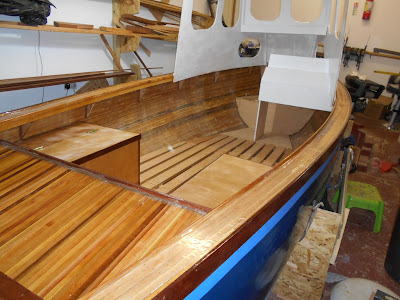Ages since I posted anything on here, been busy elsewhere.....however, I have been working on the boat when I can.
Last time, I was starting to put the ornamental planking on the decks etc. I've finished that job and gave them a coat of epoxy resin followed by a covering of fibreglass cloth. I tried cutting strips of the cloth but it shreds into threads and makes a mess and so I had a bright idea and bought rolls of three-inch fibreglass tape. I wanted the fibreglass for two reasons:
(1) to make the decks watertight.
(2) to give a less slippery walking surface
I've started to paint the wheelhouse
The next move is to work out the best materials and methods of fitting the windows. Here is some info I've researched.
Here’s a quick look at the most
popular marine window materials on the market today:
- Vinyl
and Polyester Composite: An excellent composite material, vinyl
and polyester composite fabrics offers the flexibility you need to curve
and bend along a boat’s contours easily. Fabrics made using this composite
stay tight against the frame and provide waterproof and mildew
resistance. Herculite Inc. offers
this composite combination in two top quality marine grade fabrics: Riviera and Regatta.
- Clear
Pressed Polished Coated Vinyl: A popular choice for everyday marine use,
clear pressed polished coated vinyl can be rolled back easily, which is
great for boat tops. Herculite’s Strataglass is one of the top brands
on the market for this versatile material. Another reason for the
popularity of this material it is available with scratch-resistant special
coatings, which extend the life of the material considerably. Strataglass
is one such example of a material that offers such a coating: VueShield.
- Polycarbonate: Made from a semi-rigid
clear plastic, polycarbonate windows are widely considered to be nearly
unbreakable. With polycarbonate, user visibility is clearer that other
clear plastics, plus it can be coated with scratch and UV resistant
coatings for additional protection. Polycarbonate is an excellent choice
for rugged uses. However, this textile isn’t soft like clear vinyl so it
can’t be rolled up for storage. It also tends to be pricey.
- Acrylic: Like polycarbonate,
acrylic panels are semi-rigid and provide excellent visibility. Acrylic
panels are very difficult to break, making them an excellent choice for
rugged marine use. However, acrylic fabric windows can be scratched easier
than some other options, and the panels can’t be rolled up for storage.
Acrylic can also be expensive, so it’s best used sparingly.
When it comes to marine vinyl window
materials, remember to consider the cost of each material and how that relates
to its longevity. Some materials will last longer than others, which make their
additional cost make sense over than cheaper materials that will require
frequent replacement. Alternately, if you can maintain a more affordable and
versatile fabric like polycarbonate or a clear polished pressed vinyl properly
over time, why not choose the more cost effective solution (and get benefits
like a roll up window?) How you use your boat and what your needs are will
dictate which material is best for you.
One final note: remember that the
gauge (a.k.a. thickness) of your windows affects how it will look, as well as
its clarity and flexibility. Some marine window materials come in gauges as
thick as 40 gauge and as thin as 12 gauge. Before you buy, check out this
quick buying guide on marine window materials to make sure you’re getting the perfect
choice for your needs.
The rubber seal I need I found on

https://www.sealsdirect.co.uk/shopping.asp?intDepartmentId=4#27
From the chart I chose:
(b) window rubber seal WR71 as it fits the 12mm (1/2") thick bulkhead and the 6mm (1/4") polycarbonate window.
(c) Additionally, I chose te FS34077 rubber filling strip that goes with the WR71 seal.
(d) Finally, a glazing tool GT75 with tips GT3243 appropriate to the above seals
I then uploaded a video on how to fit the rubber
VIDEO ON FITTING RUBBER SEALS





I am beginning to feel I could build a damn boat after following this step by step blog for so long. I do hope you have followers who are learning for their own enjoyment. Me...I am just along because I really like you and your stick-with-it-no-matter-what attitude. A very talented man.
ReplyDeleteGood to see you blogging again! Missed you! I'm not a boat builder as you know, but like Julie, I really like you!
ReplyDeleteHi old pal. Long time no speak - my fault, sorry. Life has been tough on my wife's health, but she is recovering rapidly now .... but its taken 18 months. Hope to get back to art in the not too distant future. Thanks for you kind comments and friendship.
Delete